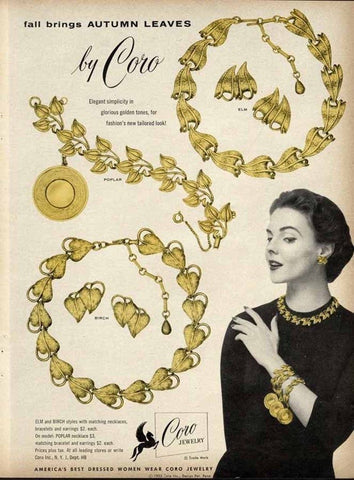Coro - 1900-1979
Coro jewelry, Cohn & Rosenberger, was founded in New York by Emanuel Cohn and Carl Rosenberger in 1901/1902 and incorporated in 1913. A factory was established in Providence, Rhode Island in 1911 with offices or plants in New York and Providence.
At times they had a presence in Chicago, Los Angeles, San Francisco, Miami, Toronto, England and Mexico as well. Great Britain mechanical patents have been found in the name of Corocraft from 1961 until 1969, which documents actual production in England (courtesy Mary Walden-Till).
Coro workmanship and finish were outstanding even on its less expensive lines. Always striving for the pretty, feminine and romantic in expression, Coro jewelry was known for its delicate yet sturdy construction, its florals and figurals.
In the late 1930s and early 1940s, to compete with Monet and Trifari especially, Coro launched several quite high-priced (even more so for that time) lines of jewelry to be sold in fine specialty stores.

Trifari may have pioneered the so-called jelly belly jewelry with carved Lucite centers, but Coro soon followed with its own figurals, also with Lucite centers, and later also with colored glass centers. Coro figurals from this era are today highly treasured by collectors.
Trifari had copied the multi-color precious stone jewelry by Cartier, it became known as fruit salad among collectors. Coro followed with its own versions, some very similar to Trifari's, others quite innovative using so-called carved glass stones.
During World War II, Coro contributed many patriotic jewelry styles, notably the Emblem Of The Americas brooch.
Designers for Coro according to Brunialti:
Gene Verrecchia [Verri] –1933 to the end of 1963
(He and his son Ron founded Gem-Craft, which is still in business as of 2019).

When shopping vintage, be sure to look for a designer's signature on every piece.

View our Exclusive Coro Collection.
